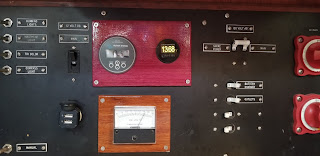Picking up where we left off, winter continued and we took full advantage of the dark, rainy (and sometimes snowy!) days- focusing our efforts on inside activities, while we waited for sunny, spring days.
The aftermath of Winter Storm Maya (yep, the storm was actually named Maya!)
My poor bike- conditions were sometimes difficult
Hiking on the Olympic Peninsula
If you recall we had issues with our batteries back in Simoom Sound on our trip last year. Not only that, they were installed in a chaotic manner, and it never really felt right. We had three 12V deep cycle batteries for our house electrical loads. Those batteries did a fairly good job of meeting our supply needs, but we never knew exactly how much charge was left in them. That's critical information for a cruising boat that anchors out a lot.
The old batteries
New Batteries!
Rerouting and sorting out the rats nest of wires.
New batteries in with bracing straps- now that is sexy!
Here is our new battery monitoring system- love it!
After removing the diesel pump we had just enough space for all 4 batteries. Using special hydraulic crimping tools borrowed from school, we were able to make custom, professional level battery cables. And as part of the project, we added a new digital battery monitor system. With this device we know exactly how much energy we have left and can manage our boat accordingly.
At this point, I think the battery and associated monitoring system will be our most valuable useful project to date. That remains to be seen, but we are elated about the new system, and the amount of confidence gained by upgrading that system.
After doing a technical, boat system project, we moved our attention to cockpit seating. While we love our boat, it did not come equipped to serve a proper happy hour. With the help of the school's woodwork shop, we tackled the problem head first, making a bench seat in the far aft of the boat, an intermediate removable bench seat, and a folding table.
This project was sooooo fun and it encompassed lots of problem solving and artistic decisions. After speaking with some knowledgeable people we decided to use tzalami, which is a Caribbean hardwood. After lots of trips between the boat and school we were able to finish all the various pieces. At this point Jenny's schedule allowed for her to be in Anacortes more. And because of this we were able to work on this together.
Jenny working on shaping our new bench seat
After a bunch of layers of varnish we installed our new projects and have loved them ever since. It really opens the boat up and makes it more comfortable.
A special shout out to our friend Evan, who built the top of our cockpit table- he even used old growth fir, which is a beautiful and rare type of wood. Thanks so much, Evan! You rock!
Varnishing the various pieces
New projects installed on Maya and looking great- we love it
Those were two of our bigger projects, but we also had a bunch of smaller projects which included cleaning out our diesel tanks, fixing our windlass, and general upgrades in organization in preparation for our big trip. These projects ensured we didn't get bored and boosted our confidence before our big summer trip.
Cleaning our dirty diesel tanks
Diesel tanks cleaned!
New anti siphon loop installed on our engine- this is a simple yet crucial installation for our diesel engine. It ensures that a siphon does not occur which would cause saltwater to flood the engine... ruining the engine.
At this point the days were getting longer so we managed to get a bunch of mini trips in the islands. We were lucky enough to be able to bring out family on several trips, which was so fun. These trips also served as practice for our big trip coming in the summer- testing out new batteries among other systems.
Fun wedding in Leavenworth- Congrats Tim and Alex!
Cool tree on Matia Island
We went fishing with our friend, John, and Jenny caught a Lingcod!
Hiking on Cypress Island
Family outing to Sucia! Thanks for coming, Chris and Bridger!
Happy hour aboard Maya (note the table is being put to use!)
Highlights from our Winter Backcountry XC Skiing Trip



































